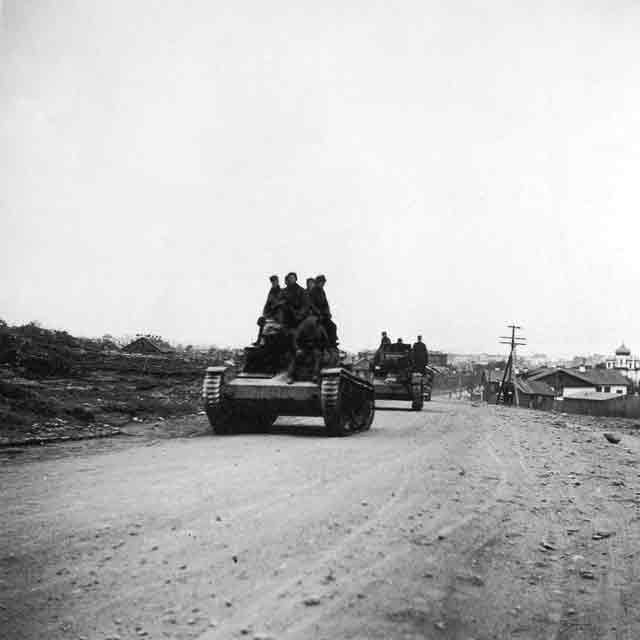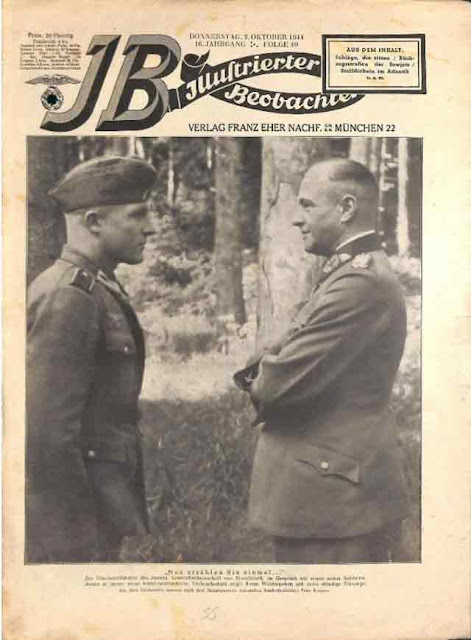Wednesday 8 October 1941
 |
| King George VI visits Gladstone Docks, Liverpool on 8 October 1941. He is standing on the bridge of a minesweeper. © IWM (A 5708). |
Harry Hopkins has told me in great detail of his encouraging and satisfactory visits with you. I can't tell you how thrilled all of us are because of the gallant defense of the Soviet armies.
I am confident that ways will be found to provide the material and supplies necessary to fight Hitler on all fronts, including your own.
I want particularly to take this occasion to express my great confidence that your armies will ultimately prevail over Hitler and to assure you of our great determination to be of every possible material assistance.The United States aid is estimated to be worth roughly $1 billion when the entire US Defense Budget for 1940 was only $1.567 billion.
 |
| "DAMAGE SUSTAINED BY THE CORVETTE HMS JASMINE IN COLLISION. 8 OCTOBER 1941, BIRKENHEAD GRAVING DOCK." © IWM (A 5713). |
 |
| 3963-ton SS Rosalie Moller on the seafloor. The Rosalie Moller is a collier sunk by the Luftwaffe (two casualties) on 8 October 1941 in the Red Sea. Luftwaffe attacks from Crete have been sinking ships in the Suez Canal area. (Middleton Ned, Shipwrecks From The Egyptian Red Sea, via wrecksite.eu. |
The chief danger is that almost all routes to Moscow are open and the weak protection along the Mozhaisk Line cannot guarantee against the surprise appearance of the enemy armored forces before Moscow. We must quickly assemble forces from wherever we can at the Mozhaisk Defense Line.The GKO prepares for the loss of Moscow by ordering plans drawn up to destroy 1,119 key installations in the city.
 |
| Bren gun mounting on a Universal Carrier Mk I, 8 October 1941 (© IWM (H 14652)). |
 |
| "HIS MAJESTY THE KING'S VISIT TO WESTERN APPROACHES COMMAND. 8 OCTOBER 1941, GLADSTONE DOCKS, LIVERPOOL." © IWM (A 5702). |
October 1941
October 1, 1941: Germans and Finns Advance in USSR
October 2, 1941: Operation Typhoon Broadens
October 3, 1941: Air Battles Near Moscow
October 4, 1941: Stalin Contemplates Defeat
October 5, 1941: Hoth Goes South
October 6, 1941: First Snowfall After Dark
October 7, 1941: Stalin Gets Religion
October 8, 1941: FDR Promises Stalin Aid
October 9, 1941: FDR Orders Atomic Bomb Research
October 10, 1941: Reichenau's Severity Order
October 11, 1941: Tank Panic in Moscow
October 12, 1941: Spanish Blue Division at the Front
October 13, 1941: Attack on Moscow
October 14, 1941: Germans Take Kalinin
October 15, 1941: Soviets Evacuate Odessa
October 16, 1941: Romanians Occupy Odessa
October 17, 1941: U-568 Torpedoes USS Kearny
October 18, 1941: Tojo Takes Tokyo
October 19, 1941: Germans Take Mozhaysk
October 20, 1941: Germans Attack Toward Tikhvin
October 21, 1941: Rasputitsa Hits Russia
October 22, 1941: Germans Into Moscow's Second Defensive Line
October 23, 1941: The Odessa Massacre
October 24, 1941: Guderian's Desperate Drive North
October 25, 1941: FDR Warns Hitler About Massacres
October 26, 1941: Guderian Drives Toward Tula
October 27, 1941: Manstein Busts Loose
October 28, 1941: Soviet Executions
October 29, 1941: Guderian Reaches Tula
October 30, 1941: Guderian Stopped at Tula
October 31, 1941: USS Reuben James Sunk
2020












